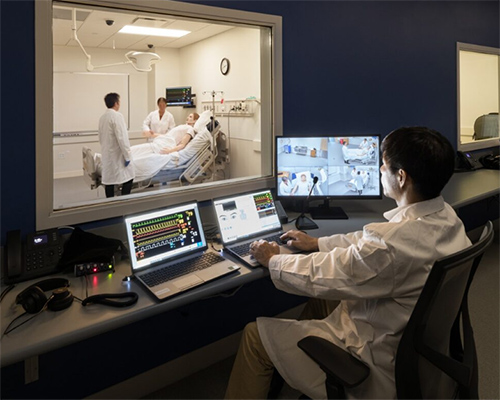
At Drexel University College of Medicine, simulation centers offer medical students the chance to work in realistic patient care environments.
The simulation centers encourage interactive curriculum development, teaching and assessment of skills for medical students as well as health care students including therapists, nurses, respiratory therapists, pharmacists and physicians in both undergraduate and graduate medical education.
The simulation centers feature life-like computer controlled robotic manikins with palpable pulses, and audible heart and lung sounds. The manikins breathe and blink, respond to injected drugs, can be intubated and defibrillated, and much more. The "patient" can even speak.
All functions are managed by technicians in nearby control rooms and video-taped for students and faculty to review in follow-up sessions. A task-training room at each center also houses individual stations such as venipuncture, suturing or birthing simulation training.
The College of Medicine collaborates with Drexel University's schools of engineering and media design to continually improve the simulation centers through research and development of new technologies.
Simulation technology is an important tool for our medical students studying at the College of Medicine's University City campus in Philadelphia, and at the College of Medicine at Tower Health campus in West Reading.
Medical Simulation Center, Health Sciences Building, University City
The simulation center is located at Drexel University College of Medicine at the University City campus in Philadelphia.
Drexel University College of Medicine
Health Sciences Building
60 N. 36th Street, Philadelphia, PA 19104
Jennifer Hamilton, MD, PhD
Associate Dean of Simulation
Email: jlh88@drexel.edu
To contact the simulation center, please complete our contact us form.

Simulation Center at the West Reading Campus
As on the University City Campus, the Medical Simulation Lab at West Reading’s Campus has patient rooms that are home to computer-controlled robotic manikins. The manikins’ vital signs and responses to “treatment” are managed by technicians. Sim Lab sessions are filmed for student and faculty review and skills assessment. Manikins can help instructors and students simulate scenarios like a live birth or bout of high blood pressure.
The medical simulation center is located at Drexel University College of Medicine at Tower Health in West Reading, Pa.
50 Innovation Way
Room 418, Fourth Floor
Wyomissing, PA 19610
John Repasch is the director of standardized patient, clinical skills and simulation at Drexel University College of Medicine at Tower Health. Learn more about John Repasch or contact him here.